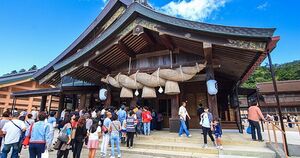Izumo no Hakuto
| Izumo no Hakuto | |||||
|---|---|---|---|---|---|
| Japanese Name | イズモノハクト | ||||
| Weapon | |||||
| Race | Beast | ||||
| Nationality | |||||
| Birthday | February 2 | ||||
| Constellation | Aquarius | ||||
| Talents | Matchmaking, Teaching people how to study | ||||
| Likes | Carrots, Cute things | ||||
| Dislikes | Spicy things, Things that soak into her skin | ||||
| Strengths | Not showing any weakness | ||||
| Weaknesses | Throwing everyone off at the worst time with a cute pose | ||||
| Hobbies | Dressing up younger than her age, Collecting cute things | ||||
Pyon. Pyon. A-pyon, pyon, pyoooon♪ I'm Izumo no Hakuto, a Train Knight that just looooves anything cute. I used to be a cram school teacher, so I know a whole lot of things!♪ Ask me anything, except my age, okay~?
Layers
| Icon | Title | Release Date | Where to Obtain |
|---|---|---|---|
| [Cute Beast Priestess] Izumo no Hakuto | 2022 June 11 (EN) | [Training Camp - Izumo no Hakuto] Event Reward | |
| [Usa Pyon Pyon♪] Izumo no Hakuto | 2022 June 1 (EN) | [A Journey of Good Encounters] Event Reward | |
| [Top Idol Energy☆] Izumo no Hakuto | 2022 June 1 (EN) | [A Journey of Good Encounters] Pick Up Gacha, Premium Gacha | |
| [Beyond the Matchmaking] Izumo no Hakuto | 2023 January 1 | [Hare Racing Mt. Cannon] Limited Gacha |
Obtained Skills
Trivia
- Izumo no Hakuto's birthday is the opening date of Izumo Taisha-mae Station in 1930.
- Izumo no Hakuto's beast motif is the lop rabbit. Unlike the erect ear of the majority of domestic rabbit breeds, lop breeds have ears loosely drooping, with the opening of the ear facing the skull.
- The name Izumo no Hakuto (出雲の白兎) means "White Hare of Izumo" in Japanese, referencing the tale of the Hare of Inaba. The legend belongs to the Izumo denrai, or tradition of myths originating from the Izumo region.
- Izumo no Hakuto's occupation as a priest and her bond matchmaking ability references the Izumo-taisha near Izumo Taisha-mae Station. Izumo-taisha is one of the most ancient and important Shinto shrines in Japan.
- Izumo no Hakuto's fangirl obsession towards Futamata is a parody of the gachikoi culture in Japan - falling in love towards an idol.
- The building in the background of [Top Idol Energy☆] is the abandoned Taisha Station, formerly the main station serving Izumo-taisha. The floor pattern features the signature stained glass of Izumo Taisha-mae Station.
- Her personality of acting young and cute as a front while occasionally letting-slip of her real age references the two train stations - the young and western-minded idol fan versus the old and traditional Shinto priestess.
Counterpart
Izumo Taisha-mae Station (出雲大社前駅) is a railway station in Izumo, Shimane, Japan, operated by the Ichibata Electric Railway. It is the closest train station to the famous Izumo Taisha Shrine. The Ichibata Electric Railway Taisha Line opened between Kawato Station and this station, and the station opened as Mikado Station on February 2, 1930. It was renamed Izumo Taisha-mae 40 years later in October 1, 1970.
By December of 1996, the station is registered as a National Tangible Cultural Property. With the transition of Ichibata Electric Railway to a holding company, the railroad business was taken over by the newly established Ichibata Electric Railway. The station became the company's station on April 1, 2006. Renovation of the station building was completed September 2012 as a joint project with Izumo City and Shimane Prefecture in conjunction with the Izumo Taisha Grand Transition and the "Myth Expo Shimane". A static exhibition space for the Deha Ni-50 is set up in the station building, and a multipurpose open space "Enmitsu Square" opens next to the station building.
Izumo Taisha-mae was designed in a Western architectural style with striking stained glass windows as a feature. Formerly there was a tower as part of the central building, this has since been removed. The station building was registered as a Tangible Cultural Property of Japan in 1996. In 2009, it was certified by the Ministry of Economy, Trade and Industry as an important Heritage of Industrial Modernisation site for its value to the promotion of mass tourism in the METI Selection of "33 Heritage Constellations of Industrial Modernization: The Sequel". The station is the only rail link between Taisha and Izumo since the closure of the JR Taisha Station and the Taisha Line in 1990. There used to be a tower in the upper center of the station building, but it has been removed.
As part of a project to promote the use of lumber produced in Shimane Prefecture, the interior of the station, including the station gates and stores, was converted to wood in collaboration with the Hii River Basin Forestry Revitalization Center and put into use from April. A Shimane Prefecture timber PR corner was set up in conjunction with the project. Wikipedia
Izumo Grand Shrine (出雲大社), officially Izumo Ōyashiro, is one of the most ancient and important Shinto shrines in Japan. No record gives the date of establishment. Located in Izumo, Shimane Prefecture, it is home to two major festivals. It is dedicated to the god Ōkuninushi (大国主大神), famous as the Shinto deity of marriage and to Kotoamatsukami, distinguishing heavenly kami. The shrine is believed by many to be the oldest Shinto shrine in Japan, even predating the Ise Grand Shrine.
A style of architecture, taisha-zukuri, takes its name from the main hall of Izumo-taisha. That hall, and the attached buildings, were designated National Treasures of Japan in 1952. According to tradition, the hall was previously much taller than at present. The discovery in the year 2000 of the remains of enormous pillars has lent credence to this. The shrine has been rebuilt every 60 to 70 years to maintain the power of the kami and maintain architectural techniques. This regular rebuilding process is called "Sengū" (遷宮) and has long been practiced at a handful of important Shinto shrines, the Ise Grand Shrine being rebuilt every 20 years. Several other buildings in the shrine compound are on the list of Important Cultural Properties of Japan.
Festivals or matsuri in Izumo are times when people gather around the god to fulfill their wish to live a happy life. One of the most important in Izumo-taisha is the Imperial Festival held on May 14. Following the Imperial Festival is the Grand Festival on May 14 and 15. In the tenth month of the traditional lunar calendar, a festival is held to welcome all the gods to Izumo Grand Shrine. It is believed that the gods convene at Izumo Shrine in October to discuss the coming year's marriages, deaths, and births. For this reason, people around the Izumo area call October kamiarizuki ("the month with gods"), but the rest of Japan calls October Kannazuki ("the month without gods"). Wikipedia
Map
Gallery
- Pages using Tabber parser tag
- Pages using DynamicPageList3 parser tag
- Weapon Artifact
- Beast
- Nishiki
- Aquarius
- Element Cut
- Element Dark
- Element Fire
- Train Knights
- Japan















